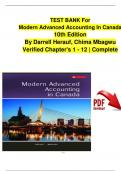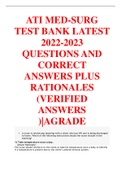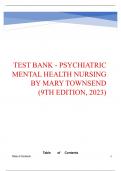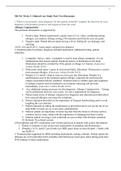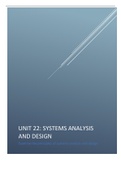TEST BANK For
Modern Advanced Accounting In Canada
10th Edition
By Darrell Herauf, Chima Mbagwu
Verified Chapter's 1 - 12 | Complete
1-1
,TABLE OF CONTENTS
CHAPTER 1 Conceptual and Case Analysis Frameworks for Financial Reporting
CHAPTER 2 Investments in Equity Securities
CHAPTER 3 Business Combinations
CHAPTER 4 Consolidation of Non-Wholly Owned Subsidiaries
CHAPTER 5 Consolidation Subsequent to Acquisition Date
CHAPTER 6 Intercompany Inventory and Land Profits
CHAPTER 7 (A) Intercompany Profits in Depreciable Assets (B) Intercompany Bondholdings
CHAPTER 8 Consolidated Cash Flows and Changes in Ownership
CHAPTER 9 Other Consolidation Reporting Issues
CHAPTER 10 Foreign Currency Transactions
CHAPTER 11 Translation and Consolidation of Foreign Operations
CHAPTER 12 Accounting for Not-for-Profit and Public Sector Organizations
1-2
, Chapter 01
Conceptual and Case Analysis Frameworks for Financial Reporting
Multiple Choice Questions
1. Which of the following would NOT be a reason to obtain a greater understanding of
accounting practices in other nations?
A. Financial results are disclosed in different currencies.
B. One needs to be aware of differing disclosure requirements from nation to nation, as this
impacts the preparation of financial statements.
C. Income-smoothing may have affected a foreign subsidiary's results; such smoothing
practices are not permitted in North America.
D. Departures from the historical cost principle may be possible in other nations.
Accessibility: Keyboard Navigation
Blooms: Remember
Difficulty: Easy
Learning Objective: 01-01 Describe and apply the conceptual framework for financial reporting.
Topic: 01-01 The Conceptual Framework for Financial Reporting
2. Which of the following would be most affected by financial statements being prepared
under different accounting principles?
A. Reduced comparability.
B. Reduced reliability.
C. Increased complexity.
D. Inaccurate asset valuations.
Accessibility: Keyboard Navigation
Blooms: Remember
Difficulty: Easy
Learning Objective: 01-01 Describe and apply the conceptual framework for financial reporting.
Topic: 01-01 The Conceptual Framework for Financial Reporting
1-3
,3. The CPA Canada Handbook - Accounting is the handbook of Canadian accounting
standards. Why do companies in Canada ensure that their financial reporting is consistent
with Canadian GAAP?
A. Their bank requires them to do so.
B. Their auditors require them to do so.
C. Reporting under the CPA Canada Handbook - Accounting is required by public companies'
boards of directors.
D. Compliance with the CPA Canada Handbook - Accounting pronouncements is usually
required by many legal statutes.
Accessibility: Keyboard Navigation
Blooms: Remember
Difficulty: Easy
Learning Objective: 01-01 Describe and apply the conceptual framework for financial reporting.
Topic: 01-01 The Conceptual Framework for Financial Reporting
4. Which decision has Canada made with respect to financial reporting for private
enterprises?
A. To adopt the IFRS standards for small and medium-sized enterprises.
B. To retain the current standards.
C. To look to US GAAP for standards.
D. To develop and maintain its own standards for private enterprises.
Accessibility: Keyboard Navigation
Blooms: Remember
Difficulty: Easy
Learning Objective: 01-02 Describe how accounting standards in Canada are tailored to different types of organizations.
Topic: 01-05 GAAP for Private Enterprises
5. Starting in 2011, what is the definition of a private enterprise (PE) under Canadian GAAP?
A. A corporation that has no public shareholders.
B. A corporation that has less than 500 shareholders and is not listed on a stock exchange.
C. A corporation which is not profit oriented.
D. A profit oriented enterprise that has none of its issued and outstanding financial
instruments traded in a public market and does not hold assets in a fiduciary capacity for a
broad group of outsiders as one of its primary businesses.
Accessibility: Keyboard Navigation
Blooms: Remember
Difficulty: Easy
Learning Objective: 01-02 Describe how accounting standards in Canada are tailored to different types of organizations.
Topic: 01-05 GAAP for Private Enterprises
1-4
,6. Which enterprises must report under IFRS in Canada?
A. All corporations, government agencies and private companies.
B. Public companies and private companies whose shareholders' equity is in excess of
$500,000,000 at any particular year end.
C. Public companies, private companies and not-for-profit organizations.
D. Publicly accountable enterprises.
Accessibility: Keyboard Navigation
Blooms: Remember
Difficulty: Easy
Learning Objective: 01-02 Describe how accounting standards in Canada are tailored to different types of organizations.
Topic: 01-04 GAAP for Publicly Accountable Enterprises
7. What approach did Canada first decide to take with respect to convergence with IFRS?
A. Harmonization of CPA Canada Handbook with IFRS.
B. Substituting IFRS for Canadian GAAP when approved by the IASB.
C. Adopting some but not necessarily all IFRSs by reviewing them on a case by case basis.
D. Reviewing them with all publically accountable entities to see which ones would be
acceptable.
Accessibility: Keyboard Navigation
Blooms: Remember
Difficulty: Easy
Learning Objective: 01-02 Describe how accounting standards in Canada are tailored to different types of organizations.
Topic: 01-04 GAAP for Publicly Accountable Enterprises
8. What choice(s) do private enterprises have in their financial reporting in Canada?
A. They have no choice at all; they will need to report under IFRS.
B. They may elect to continue with differential reporting.
C. They may adopt accounting principles that are appropriate to the circumstances.
D. They may elect to report under either IFRS or ASPE but once adopted, must use all the
standards.
Accessibility: Keyboard Navigation
Blooms: Remember
Difficulty: Easy
Learning Objective: 01-02 Describe how accounting standards in Canada are tailored to different types of organizations.
Topic: 01-05 GAAP for Private Enterprises
1-5
,9. For which of the following types of organizations does the CPA Canada Handbook not
provide specific accounting standards?
A. Publicly accountable enterprises.
B. Private enterprises.
C. Not-for-profit organizations.
D. Proprietorships.
Accessibility: Keyboard Navigation
Blooms: Remember
Difficulty: Easy
Learning Objective: 01-02 Describe how accounting standards in Canada are tailored to different types of organizations.
Learning Objective: 01-03 Identify some of the differences between IFRS and ASPE.
Topic: 01-04 GAAP for Publicly Accountable Enterprises
Topic: 01-05 GAAP for Private Enterprises
Topic: 01-06 GAAP for Not-for-Profit Organizations
Topic: 01-07 GAPP for Government and Other Government Organizations
10. Which of the following is NOT a reason why a Canadian private company would elect to
report under IFRS?
A. The company is planning to go public in the near future.
B. The company seeks comparability with public companies of a similar size.
C. It is likely to be less expensive than reporting under ASPE.
D. The company is a subsidiary of a Canadian public company.
Accessibility: Keyboard Navigation
Blooms: Remember
Difficulty: Easy
Learning Objective: 01-02 Describe how accounting standards in Canada are tailored to different types of organizations.
Topic: 01-05 GAAP for Private Enterprises
11. The current ratio measures:
A. liquidity.
B. solvency.
C. profitability of assets.
D. profitability of owners' investment.
Accessibility: Keyboard Navigation
Blooms: Remember
Blooms: Understand
Difficulty: Easy
Learning Objective: 01-04 Analyze and interpret financial statements to assess the impact of different accounting methods on key financial
statements ratios.
Topic: 01-08 Analysis and Interpretation of Financial Statements
1-6
,12. The formula for the current ratio is:
A. current assets - current liabilities
B. current assets/current liabilities
C. total debt/shareholders' equity
D. net income/shareholders' equity
Accessibility: Keyboard Navigation
Blooms: Remember
Difficulty: Easy
Learning Objective: 01-04 Analyze and interpret financial statements to assess the impact of different accounting methods on key financial
statements ratios.
Topic: 01-08 Analysis and Interpretation of Financial Statements
13. The debt-to-equity ratio measures:
A. liquidity.
B. solvency.
C. profitability of assets.
D. profitability of owners' investment.
Accessibility: Keyboard Navigation
Blooms: Remember
Blooms: Understand
Difficulty: Easy
Learning Objective: 01-04 Analyze and interpret financial statements to assess the impact of different accounting methods on key financial
statements ratios.
Topic: 01-08 Analysis and Interpretation of Financial Statements
Short Answer Questions
14. One of the underlying assumptions of the Historical Cost Principle is that a stable unit of
measure (currency) should be used for Financial Reporting. Is this always the case?
The Historical Cost Principle is not very useful when inflation rates are high. As a result of
the eroding purchase power associated with periods of high inflation, many countries have
had to experiment with price-level adjustments. These adjustments often include asset
revaluations to reflect their current values.
Accessibility: Keyboard Navigation
Blooms: Remember
Blooms: Understand
Difficulty: Easy
Learning Objective: 01-01 Describe and apply the conceptual framework for financial reporting.
Topic: 01-01 The Conceptual Framework for Financial Reporting
Topic: 01-02 Professional Judgment
1-7
,15. X Inc. and Y Inc. are virtually identical companies with identical cost structures and very
similar business practices operating in the same lines of business. X Inc. is a public company
based in Canada and follows IFRS while Y Inc. is a private enterprise based in Canada and
follows ASPE. The following were the condensed income statements for both companies for
the last year before both adopted IFRS.
X Inc. Y Inc.
Sales: $1,000,000 $2,000,000
Less:
Cost of Goods Sold $500,000 $1,600,000
Gross Margin $500,000 $400,000
Administrative Expenses $200,000 $300,000
Net Income: $300,000 $100,000
Required:
Given the information provided, what are some possible causes for the differing results of
these companies?
There could be many possible explanations for these differing results. Y Inc.'s net income is
$100,000, compared to X Inc.'s $300,000. Conversely, Y Inc.'s sales are twice those of X Inc.
What is particularly noteworthy is Y Inc.'s 20% gross margin compared to X Inc.'s 50% gross
margin. This could be due to the accelerated depreciation on Y Inc.'s property, plant and
equipment or provisions made for future maintenance costs.
Smoothing practices may have been applied to reduce Y Inc.'s income, and of course, its tax
liability. Y Inc.'s income may have been further reduced by higher estimates (for example:
bad debt expense, warranty costs and so forth) which are not necessarily be indicative of
economic conditions.
Note: Once again, the above analysis is not necessarily exhaustive. Students may be able to
identify other valid differences.
Accessibility: Keyboard Navigation
Blooms: Remember
Blooms: Understand
Difficulty: Medium
Learning Objective: 01-02 Describe how accounting standards in Canada are tailored to different types of organizations.
Learning Objective: 01-03 Identify some of the differences between IFRS and ASPE.
Topic: 01-03 Accounting Standards in Canada
Topic: 01-04 GAAP for Publicly Accountable Enterprises
Topic: 01-05 GAAP for Private Enterprises
1-8
,16. Briefly discuss the external users need for high quality financial information.
External users require high quality financial information to enable them to assess the
likelihood of making a reasonable return with an acceptable level of risk. It is important that
the quality of the financial statements provide useful and reliable information to assess the
prospects of future cash flows or future earnings.
The users want the information to faithfully represent what has happened during the past
period. Distorting the real situation by using accounting methods that do not match the actual
situation or managing earnings to recognize revenue earlier or delay reporting expenses to a
later period are not a faithful representation of the actual situation. The result is the external
users are not able to make appropriate decisions as to whether to increase, decrease, or
maintain their level of participation with the reporting entity in their capacity as investor,
creditor, supplier, and/or customer.
Accessibility: Keyboard Navigation
Blooms: Remember
Blooms: Understand
Difficulty: Easy
Learning Objective: 01-04 Analyze and interpret financial statements to assess the impact of different accounting methods on key financial
statements ratios.
Topic: 01-08 Analysis and Interpretation of Financial Statements
17. What disclosure requirements must be met when a Canadian company adopts IFRS for the
first time?
1. The company must reconcile its equity reported under the previous GAAP to its equity in
accordance with IFRS for both the date of transition to IFRS and the end of the latest period
reported under the previous GAAP.
2. The company must reconcile its total comprehensive income in accordance with IFRS to
that reported in the latest statements prepared under the previous GAAP.
3. The company must provide sufficient detail to enable users to understand the material
adjustments to the statement of financial position, the statement of comprehensive income and
the statement of cash flows.
Accessibility: Keyboard Navigation
Blooms: Remember
Difficulty: Medium
Learning Objective: 01-02 Describe how accounting standards in Canada are tailored to different types of organizations.
Topic: 01-03 Accounting Standards in Canada
Topic: 01-04 GAAP for Publicly Accountable Enterprises
1-9
, 18. Provide the procedures used to analyze a company's financial statements to determine its
future prospects.
Procedures to analyze a company's financial statements:
Perform common-size analysis and interpret the results.
Review the accounting policies and estimates used by the company to ensure that they are
appropriate.
Adjust the financial statements, as necessary, to use appropriate accounting policies and
estimates.
Calculate the ratios for one or more periods.
Compare the ratios to relevant benchmarks.
Interpret the results of the analysis to determine whether they are better, worse, or the same as
the benchmark.
Decide whether to increase, decrease, or maintain the level of participation with the reporting
entity.
Accessibility: Keyboard Navigation
Blooms: Remember
Difficulty: Easy
Learning Objective: 01-04 Analyze and interpret financial statements to assess the impact of different accounting methods on key financial
statements ratios.
Topic: 01-08 Analysis and Interpretation of Financial Statements
Chapter 02
Investments in Equity Securities
Multiple Choice Questions
1-10

